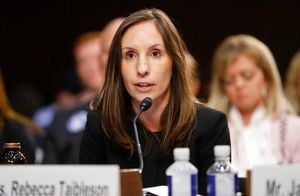Egypt’s comprehensive health insurance system has reached a significant milestone, with 495 accredited entities now contracted to provide services as of August 2025, according to the General Authority for Comprehensive Health Insurance. This expansion, announced on September 18, 2025, marks a major step toward the nation’s goal of universal health coverage and reflects a concerted effort to ensure that citizens across all participating governorates have access to high-quality medical care.
In a statement reported by the Egyptian news outlet Masrawy, Mai Farid, Executive Director of the General Authority for Comprehensive Health Insurance, emphasized the diversity and scale of the system’s provider network. "The system includes a variety of contracts between governmental bodies and the private sector, with the private sector accounting for 29% of total contracts," Farid explained. This, she noted, demonstrates the ongoing expansion of the network and the increasing involvement of different sectors in healthcare delivery.
The comprehensive insurance system’s contracted entities are spread across a wide range of providers. At the forefront is the General Authority for Healthcare, which leads with 286 entities. The private sector follows with 144 contracted entities. Other contributors include the Specialized Medical Centers Authority (19 entities), university hospitals (11), charitable organizations (10), the Armed Forces (7), the Ministry of Interior’s Medical Services Sector (6), the Ministry of Health (4), and the Suez Canal Authority (4). Additionally, there is one contracted entity each from the business sector and the Egyptian National Railways.
Dr. Heba Atef, Head of the Central Administration for Healthcare Providers at the Authority, provided a detailed breakdown of the contracted facilities. The list includes 199 primary care units, 66 primary care centers, 80 general and integrated hospitals, 49 specialized hospitals, 11 specialized medical centers, 6 specialized clinics, 31 medical laboratories, 13 radiology centers, 28 optometry centers, and 12 pharmacies. This broad spectrum of services is designed to give citizens the freedom to choose the most suitable provider for their needs, while also ensuring comprehensive coverage for all segments of society in the regions where the system has been implemented.
The significance of this expansion goes beyond mere numbers. As Dr. Atef stressed, "These expansions reflect the state’s commitment to enhancing health equity and protecting citizens from the financial burdens of treatment." The comprehensive insurance system aims to establish a sustainable financing model and encourage investment in the health sector through partnerships with both public and private entities, as well as civil society organizations.
According to the General Authority, the system’s growth is not just about increasing the number of providers. Future plans include further expanding the base of contracted entities, attracting new investments, and introducing full digital transformation across the insurance platform. There is also a focus on intensifying community awareness campaigns to ensure that all citizens can benefit from the services offered by the comprehensive health insurance system.
This approach aligns closely with Egypt’s Vision 2030 goals for the health sector and the United Nations’ Sustainable Development Goals. By widening access to healthcare and promoting partnerships across sectors, the system aims to create a more resilient and equitable healthcare environment for all Egyptians.
The journey toward comprehensive health coverage in Egypt has not been without its challenges. Historically, access to quality healthcare has varied significantly by region and socioeconomic status. Many Egyptians, particularly those in rural or underserved urban areas, have struggled with high out-of-pocket expenses or limited options for specialized care. The comprehensive health insurance system was introduced as a response to these disparities, seeking to create a unified, sustainable framework that could bridge these gaps.
Since its inception, the system has steadily expanded its reach. The inclusion of a wide variety of providers—from government-run hospitals to private clinics and charitable organizations—has been key to this growth. The 29% share of private sector contracts reflects the government’s recognition that public-private partnerships are essential for meeting the diverse needs of the population. This collaborative approach has also encouraged innovation and competition, which in turn can drive improvements in service quality and efficiency.
One of the system’s defining features is its emphasis on primary care. With 199 primary care units and 66 centers now under contract, the insurance platform is designed to provide a strong foundation for preventative care and early intervention. This focus is in line with global best practices, which emphasize the importance of accessible primary care in improving health outcomes and reducing the long-term costs of chronic disease management.
The expansion of specialized services is equally noteworthy. The addition of 49 specialized hospitals, 11 specialized medical centers, and numerous diagnostic and optometry centers ensures that patients requiring advanced care can access it without excessive delays or financial hardship. The presence of 12 contracted pharmacies further supports the continuity of care, making it easier for patients to obtain necessary medications within the insurance framework.
Digital transformation is another pillar of the system’s future strategy. By moving toward full digitization, the Authority aims to streamline administrative processes, enhance data security, and improve patient experience. Digital health records, online appointment scheduling, and electronic claims processing are all expected to play a role in making the system more efficient and user-friendly.
Public awareness remains a critical challenge. Despite the rapid expansion of the provider network, many citizens are still unfamiliar with the benefits and procedures of the comprehensive health insurance system. To address this, the Authority has pledged to intensify community outreach and education efforts, ensuring that information about enrollment, coverage, and service options is widely accessible.
As Egypt moves forward, the comprehensive health insurance system stands as a cornerstone of the country’s broader health reform agenda. By combining sustained government investment, private sector participation, and a focus on equity and innovation, the system is poised to deliver on its promise of universal health coverage. The coming years will be crucial as the Authority works to further expand its network, integrate new technologies, and build public trust in the system.
For now, the milestone of 495 contracted entities serves as a testament to the progress made—and a reminder of the work still to be done to ensure that every Egyptian can access the care they need, when they need it, without financial hardship.






